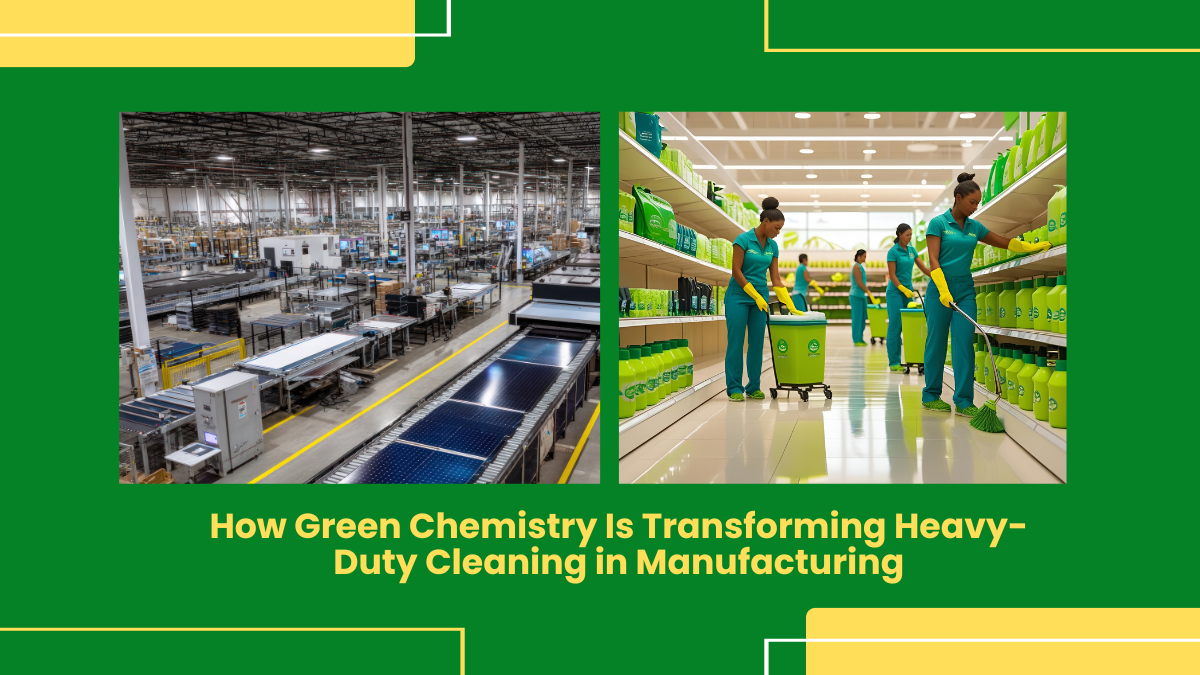Heavy-duty cleaning in manufacturing environments has always been a demanding task. Removing layers of grease, oil, and carbon buildup from machinery often requires strong chemical agents. While these traditional cleaners deliver fast results, they also bring serious side effects—environmental pollution, worker health risks, and equipment wear.
Today, green chemistry in cleaning is reshaping how industries approach maintenance. It’s not just about keeping machines clean—it’s about protecting people, preserving the planet, and maintaining production efficiency.
The Problem: Conventional Cleaning Methods and Their Hidden Costs
Manufacturing units depend on powerful cleaners to maintain operational hygiene. But traditional industrial cleaners often rely on harsh substances that solve one problem and create several others.
1. Worker Health and Safety Risks
Chemical-heavy cleaners contain volatile organic compounds (VOCs), solvents, and acids that emit toxic fumes and irritate skin and lungs.
Impact:
- Frequent exposure leads to respiratory issues and allergies.
- Increased need for personal protective equipment (PPE).
- Higher absenteeism due to chemical-related illnesses.
2. Environmental Pollution
Many manufacturing plants discharge chemical residues into drainage systems, contaminating water bodies and soil. These pollutants harm aquatic life and disrupt ecosystems.
Impact:
- Non-biodegradable waste increases treatment costs.
- Negative impact on local biodiversity.
- Difficulty meeting environmental compliance standards.
3. Equipment Corrosion and Downtime
Harsh cleaners don’t just remove grime—they also damage the very surfaces they’re meant to protect. Acidic formulations corrode metals, seals, and coatings.
Impact:
- Reduced equipment lifespan.
- Frequent repairs and maintenance delays.
- Unplanned production downtime.
4. Rising Operational and Compliance Costs
Waste disposal regulations are becoming stricter globally. Managing, storing, and disposing of hazardous cleaning chemicals adds cost and complexity.
Impact:
- Higher operational expenses.
- Potential legal penalties for improper disposal.
- Increased documentation and audits for safety compliance.
The Solution: Green Chemistry in Cleaning
Green chemistry focuses on creating cleaning agents that are effective yet safe for humans and the environment. Instead of toxic solvents, these solutions use biodegradable, plant-derived ingredients that achieve deep cleaning without side effects.
1. What Is Green Chemistry in Cleaning?
Green chemistry applies chemical principles that minimize waste, reduce toxicity, and use renewable materials. In cleaning, this means formulating products that:
- Use natural surfactants and enzymes instead of synthetic chemicals.
- Are biodegradable and water-based.
- Require less water and energy for rinsing.
- Deliver equal or better cleaning performance.
2. Why Manufacturers Are Making the Shift
Manufacturers are increasingly adopting green chemistry in cleaning to meet sustainability goals and regulatory demands. Beyond compliance, the shift also makes business sense.
Key Benefits:
- Reduced exposure to harmful substances.
- Lower waste treatment and disposal costs.
- Longer equipment life and improved efficiency.
- Positive corporate image and ESG (Environmental, Social, and Governance) compliance.
How Green Chemistry Works in Heavy-Duty Cleaning
Eco-based industrial cleaners developed using green chemistry principles are engineered for performance without the hazards. Here’s how they achieve effective heavy-duty cleaning.
1. Biodegradable Ingredients
These cleaners use naturally derived surfactants that break down grease, oil, and dirt while safely decomposing after use. No harmful residues remain on equipment or in wastewater.
2. Enzyme-Driven Action
Enzymes replace aggressive chemicals by targeting specific contaminants—like protein-based stains, oil films, or carbon deposits—without damaging surfaces.
3. Neutral pH Formulation
Unlike acidic or caustic solutions, neutral pH cleaners protect sensitive equipment parts and seals. They’re ideal for stainless steel, aluminum, and painted surfaces.
4. Water-Saving Efficiency
Green cleaners require less rinsing, which saves water and reduces effluent generation—critical for plants aiming to reduce water footprints.
5. Safe Disposal
Since eco-based cleaners are biodegradable, they simplify waste management and help plants meet discharge regulations with minimal environmental impact.
Prevention Tips for Sustainable Cleaning Practices
Switching to green chemistry-based products is a strong first step, but maintaining long-term sustainability requires continuous prevention and planning.
1. Schedule Regular Cleaning
Routine cleaning prevents buildup of grease and grime, reducing the need for intensive chemical treatments later.
2. Train Maintenance Teams
Educate cleaning staff on proper dilution ratios, application techniques, and eco-friendly waste handling. Proper use ensures maximum cleaning efficiency with minimal waste.
3. Monitor Air Quality and Chemical Use
Install monitoring systems or digital signage that display air quality data, cleaning schedules, and safety reminders across your facility.
4. Implement a Closed-Loop Cleaning Process
Use systems that recycle and filter cleaning solutions for reuse. This minimizes waste and conserves water.
5. Partner with Sustainable Suppliers
Work with vendors that provide certified green cleaning products and support documentation for environmental compliance.
How Ecochem Supports Green Chemistry in Industrial Cleaning
At Ecochem, we combine sustainable science with digital innovation. Our eco-based industrial cleaners are formulated using green chemistry principles—safe, biodegradable, and powerful enough for heavy-duty cleaning in manufacturing environments.
But Ecochem doesn’t stop at cleaning products. We also offer a digital signage platform that connects with over 100 applications, helping industries communicate maintenance, safety, and sustainability updates in real time.
Here’s How Ecochem Adds Value:
- Eco-Based Cleaners: Non-toxic, pH-balanced, and safe for both workers and equipment.
- Digital Integration: Display cleaning schedules, eco-safety guidelines, and energy-saving insights across digital screens.
- Operational Efficiency: Real-time visibility reduces cleaning downtime and improves safety compliance.
- Sustainability Reporting: Showcase your company’s green initiatives through live dashboards and signage integration.
By merging eco-based cleaning solutions with digital signage, Ecochem empowers manufacturing plants to clean smarter, communicate better, and operate more sustainably.
Why Green Chemistry Is the Future of Industrial Cleaning
The manufacturing industry is evolving—and so are its cleaning needs. The push for sustainability, combined with worker safety and cost efficiency, is leading more facilities to rethink traditional cleaning practices.
Green chemistry in cleaning offers a perfect balance between performance and protection. It allows industries to maintain hygiene standards without sacrificing environmental integrity or operational productivity.
By adopting these eco-safe solutions, companies can:
- Minimize their carbon footprint.
- Safeguard employee health.
- Extend equipment life.
- Strengthen their reputation as environmentally responsible manufacturers.
And with Ecochem’s combined expertise in green cleaning and digital communication, the path toward sustainable industrial cleaning becomes simpler and more measurable.
Practical Example: Heavy-Duty Degreasing Without Toxins
Traditional degreasers often contain hydrocarbons and corrosive acids. These not only endanger workers but also corrode machine surfaces and create disposal challenges.
Green chemistry-based degreasers, such as Ecochem’s eco-safe formulations, use biodegradable surfactants that dissolve oil and grease without the harmful side effects. The result?
- Effective cleaning of conveyors, motors, and heavy machinery.
- Safe wastewater discharge with minimal environmental impact.
- Reduced need for protective gear and ventilation.
This is a practical example of how green chemistry principles can improve cleaning performance while maintaining sustainability.
Prevention Tips for Long-Term Benefits
- Use Real-Time Monitoring:
Integrate Ecochem’s signage to remind teams about safe cleaning cycles and eco-cleaner usage. - Conduct Regular Audits:
Periodically review cleaning performance, chemical inventory, and water usage to identify improvement opportunities. - Encourage Cross-Departmental Training:
Include sustainability education in your facility’s safety training programs. - Track Results Digitally:
Display cleaning performance data and sustainability metrics through Ecochem’s digital dashboards to promote accountability. - Promote Awareness:
Use internal signage campaigns to highlight your commitment to green chemistry and environmental care.
Final Thoughts
Green chemistry in cleaning is more than a scientific concept—it’s a shift toward responsibility and smarter manufacturing. It helps companies reduce chemical dependency, cut operational costs, and align with global sustainability goals.By choosing Ecochem’s eco-based cleaning solutions and leveraging our connected digital signage, your manufacturing facility can maintain impeccable hygiene standards while leading the way in environmental stewardship.
FAQ’S
What is green chemistry in cleaning?
It’s the use of biodegradable, non-toxic ingredients to clean industrial surfaces safely and sustainably.
Are green chemistry-based cleaners effective on heavy machinery?
Yes, they remove oil, grease, and dirt without harming metal or painted surfaces.
How do green cleaners reduce environmental impact?
They’re biodegradable and produce minimal toxic waste, protecting soil and water systems.
Are green chemistry products expensive?
They may cost slightly more initially but reduce maintenance, disposal, and compliance costs long-term.
How does Ecochem support green cleaning?
Ecochem provides eco-based industrial cleaners and digital signage to manage cleaning schedules, compliance, and sustainability communication.
Written By: Vinny Jain

